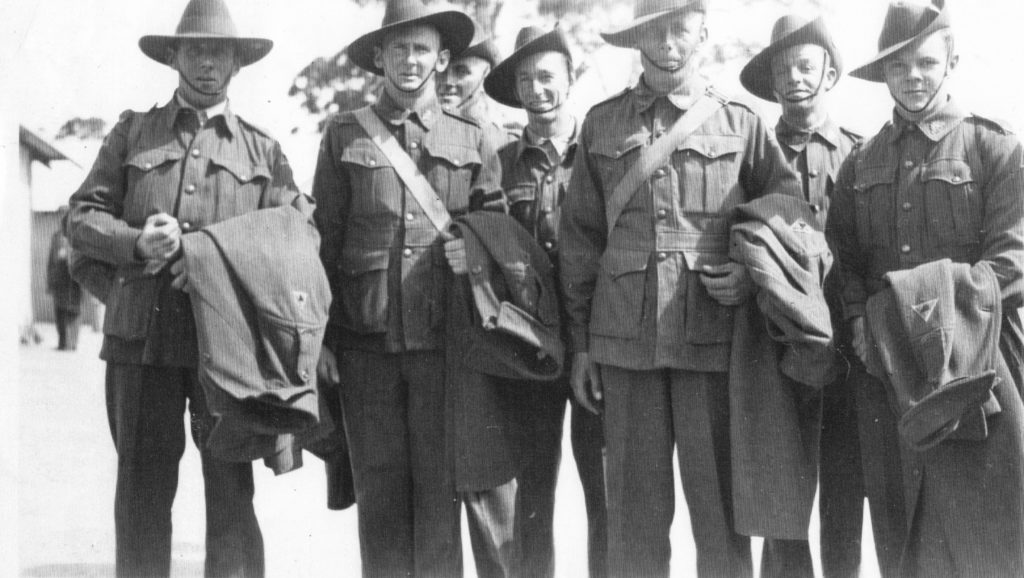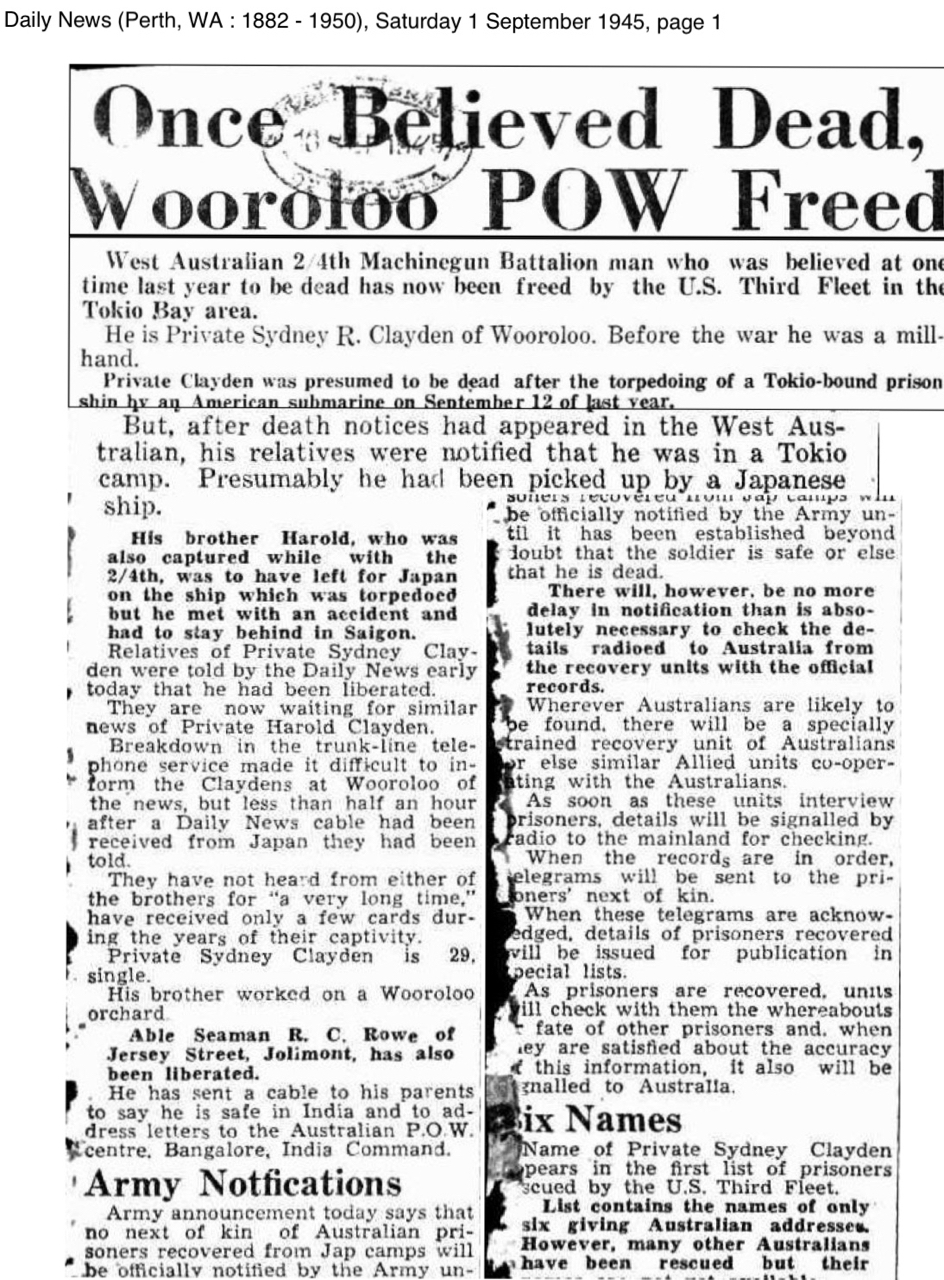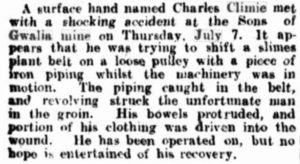The Soldier's Details

- Surname:
- Climie
- First Name:
- Austin Newman
- Nick Name:
- Aussie
- Rank:
- Corporal (Promoted on 12.2.1942)
- Regimental #:
- WX4927
- Company:
- 'C' Company, No 11 Platoon.
- Enlisted:
- 23.07.1940
- DOB:
- 23.10.1907
- Place of Birth:
- Perth, Western Ausltalia
- Father's Name:
- Murray Climie (Stepfather: William Thomas Jacks)
- Mothers's Name:
- Eliza Martha Climie (nee Newman)
- Religion:
- Anglican
- Pre-war Occupation:
- Truck Driver
- Memorial:
- Yokohama British Commonwealth Cemetry, Australian Section, Plot A, Row A, Grave 15, Age 37.
- Singapore:
- Selarang Camp Changi
- Force:
- 'A' Force Burma, Green Force, No. 3 Battalion
- Camps Thailand:
- Tamarkan, River Valley Road Transit Camp
- Camps Burma:
- Victoria Point, Kendau 4.8km, Thetkaw, Khonkan, Meiloe, Aungganaung
- Camps Japan:
- Kawasaki Camp No. 14D
- POW#:
- 2896 and 6103
- Japan:
- Rakuyo Maru Party, Kumi No 36 (rescued)
- Cause of Death:
- Killed during an Allied air raid
- Place of Death:
- Kawasaki Camp No. 14D
- Date of Death:
- 13.07.1945
General Description


Aussie Climie survived the sinking of ‘Rakuyo’ Maru, was rescued by the Japanese, however tragically died in Japan 13 July 1945 during an Allied Air Raid. He was 37 years of age.
Read the story Members of 2/4th nominated for Medal but not awarded.
And the story Surviving the Sinking of the Rakuyo Maru written by Roy Cornford NX44955 of the 2/19th Battalion, courtesy of Peter Winstanley.
Aussie had been selected at Singapore to work on the Burma end of the railway, with ‘A’ Force Green Force No. 3 Battalion.
Please read about Green Force No. 3 Battalion.
Climie first worked at Victoria Point, possibly Tavoy then Kendau 4.8km, Thetkaw 14 km, Meiloe 75 km, Aungganaung 105km before being evacuated with most of the POWs in Burma to Thailand. Climie going to Tamarkan where he was to later on 27 March 1944 selected to work in Japan. This trip would be many months in the pipeline. The POWs were sent by rail to Saigon, French Indo-China from where they were supposed to sail for Japan. They spent about 2 months here working on the docks and other local labouring jobs before being sent back to the rail head at Phom Penh to travel to Singapore. (The Japanese realised it would be futile to send any further shipping from this area as the US submarines had maintained a very successful blockade – one captain said he could walk all the way to Japan stepping on periscopes!)
Back to Singapore by rail the POWs were accommodated at River Valley Road Camp and began working at the docks and other labouring jobs until ‘Rakuyo’ Maru arrived.
At Tamarkan Aussie was selected for Japan on 27th March 1944. Following the sinking of ‘Rakuyo Maru’ in the South China Sea Aussie (along with Bert Wall, Syd Clayden ) were amongst about 80 POWs in three rafts rescued by a Japanese Corvette, transhipped by Kibibi Maru via Hainan Island. (Wall, Clayden and Climie were all from ‘C’ Coy – Clayden and Climie with 11 Platoon and Wall was with 12 Platoon).
‘Three rafts of POWs were picked up by a Japanese Corvette. The men numbering about 80 or 82 had to climb up the side of the corvette on rope (ladder) after which they were made to sit on deck up front. Most had little or no clothing. They were given nothing to drink.
Climie, Syd Clayden and Bert Wall were with this above group.
Wall went to Sakata where Rowley Richards was the only Australian Doctor amongst about 40 Australians and 200 British – there were some British doctors. Rowley Richards was regarded very highly as a doctor.
Climie and Clayden were sent to Kawasaki Camp 14D – within the Tokyo military jurisdiction. ‘ (This information was relayed by Bert Wall after the war.)
Having survived several POW years including working on the Burma-Thai Railway, the sinking of the ‘Rakuyo Maru’, being picked up by the Japanese in the South China Sea 2-3 days later, Aussie and Clayden were sent to work at the Kawasaki Camp (Wall was sent to Sakata in a group of about 40 Australians). In July 1945 Aussie was killed during an Allied air raid. It seems so unfair so survive so much and the war ended in August!
We also believe Clayden was injured during these raids (or possibly ill) because he was recovered from Shinagawa Main Hospital Camp.

The above story continues (can be read on Syd Clayden’s page) however we have included just this part to show Clayden’s recovery. Quite miraculous since his family had been informed of his earlier death.




Yokohama War Cemetery, Japan.

Aussie’s parent’s Muray Felix Austin Climie (born New Zealand) and Eliza Martha Newman married September 1904 at Tea Tree Gully, South Australia.

In 1910 Murray Climie at the age of 27 years was killed in a mining accident at Sons of Gwalia mine. His son Aussie would have been about 3 years of age. One can’t imagine was a terrible calamity this would have been for this young mother and her son.


Although the name used is Charles Climie, it is believed to be an error in his christian name.

During 1942 when Aussie was a POW at Singapore his mother died in May. It is unknown whether Aussie ever learnt of his mother’s death before he died. Eliza Climie had remarried, and Aussie had at least one half-sister Dorothy Bransby, who he recorded as his NOK on his enlistment papers.
Not only was the early death of Ossie’s father Murray a huge loss for his young wife and son – Murray, his mother Louisa Isabella Climie (nee Clarkson) and his siblings endured some very truamatic years. The following is not in any way intended to hurt family members – however it does show family relations and events which affected the Climie family for decades.
Murray Climie’s parents Campbell Austin Climie and Louise Isabella Clarkson married 1875 in Victoria.

There were about 4 daughters and two sons born.
In about 1895, about 20 years later, Campbell Climie moved to WA to the goldfields. It appears that at about this time Louisa and family remained in Victoria. These arrangements were not unusual. The Goldfields lured thousands of men from around Australia and other parts of the world. Men looking for work, some looking to make their fortune. Conditions were not ideal for wives and families. Often miners lived in very rough quarters nearby to the mines whilst their families lived in towns such as Coolgardie.
Aussie Climie’s father Murray was born about 1883 and he had three younger sisters, an older sister and an older brother George.




1904 – Murray Climie and Eliza Martha Newman marry SA. They move to WA.
1907 – Murray and Eliza have a son, Austin Newman Climie.
1910 – Murray Climie aged 27 died in a mining accident.
1915 – Murray’s sister-in-law dies aged 19 years. She had married Murray’s only brother George in 1913.
1917 – George Climie dies aged 37 years.
1920 – Louise Isabella Climie (nee Clarkson) died.


In 1920, Aussie’s grandmother Louisa Isabella Climie died.


In Oct 1986 ‘Borehole Bulletin’ a letter was printed from Mr. D.E. Powell who had gave his address as ‘Int’l. Airport Projects, Riyadh, Kingdom of Saudi Arabia’. He was a nephew of WX Edward Charles (Ted) Hardey ‘D’ Company and was hoping somebody from 2/4th could provide any information.
The following information was included in his letter:
Powell thought his uncle Ted Hardey had seen service in France WW1 and enlisted again May 1941 with a mate, Climie. Climie had in fact enlisted July 1940 and was with ‘C’ Company. Ted Hardey enlisted May 1941, also ‘C’ Coy aged 43 years. He gave his address as 29 Woodville Street, North Perth.
Hardey and Climie had been mates together and kangaroo shooting (for payment in those days) around Carnarvon. Hardey’s family resided in Carnarvon.
Read further about Hardey
Both men were selected with ‘A’ Force Burma, Green Force No. 3 Battalion to work on the northern end of railway in Burma. Their ships departed Singapore Harbour 14 May 1942 for southwest Burma. Green Force disembarked at Victoria Point, with their main focus on repairing and extending the airfield. At completion ‘A’ Force Green Force No. 3 Battalion were the first Burma work party for the railway and arrived Kendau 4.8 km Camp commencing work 1 October 1942. The two men moved to other designated camps – Thetkaw 14km, Meiloe 75k, Augganaung 105km between 1 Oct 1942 to end of December 1943. At this point when the railway was completed, the Japanese transported all POWs working in Burma south to Thailand to one of 4 or 5 large Camps, depending on their health.
Hardey and Climie were very fortunate to remain fairly healthy during the time and arrived at Tamarkan where the POWs were able to take advantage of better food and living conditions. Climie was selected fit to go to Japan with what would become ‘Rakuyo Maru’ Party. Powell wrote ‘Hardey missed out on this draft – he was with a work or ration party. Eddie tried every way to get himself into ‘Rakuyo Maru’ Party – his efforts unsuccessful.’
Climie reached Japan having survived his time in the South China Ocean until he was picked up with survivors by a Japanese ship. The POWs already traumatised and injured were not treated like survivors – in fact were treated appallingly – most were by then without clothes, or just ‘Jap Happies’ and made to sit in the open of the front of the vessel – were not given anything to drink) then delivered to Japan having first sailed to Taiwan (or Hainin Island?)
Climie was really out of luck! He was killed during an Allied air raid over Kawasaki Camp 14D on 13 July 1945 – just one month short of the end of the war. He was 37 years old.
Hardey fared a little better in that he did make it home – he sailed to Japan with ‘Awa Maru’ Party but had the misfortune to be sent to Omuta, the Mitsui Camp which was run by American Mafia and brutal Japanese guards.
Please read official records of POW accommodation, work conditions, food, etc.
Camp Locations:
- River Valley Road Camp - Singapore
- Selarang Camp Changi - Singapore
- Tamarkan, Tha Makham 56k - Thailand
- Aungganaung,105Kilo - Burma
- Kendau, Kandaw, 4 Kilo - Burma
- Meilo, 75 Kilo, 340k - Burma
- Saigon - French Indo China
- Victoria Point, Kawthoung - Burma. \'A\' Force, Green Force No. 3 Btn
- Thetkaw 14 Kilo - Burma
- Kawasaki 14D - Shibaura







